
Manufacturer's Specifications:
Frequency Response: 20 Hz to 20 kHz, ±1.5 dB.
Signal/Noise Ratio: 80 dBA with Dolby C NR.
Separation: 35 dB. Erasure: 75 dB.
Input Sensitivity: Mike, 0.15 mV; line, 15 mV; DIN, 0.4 mV; AUX, 40 mV.
Output Level: Line, adjustable from 0.5 to 2.0 V; headphones, 10 V at 56 ohms.
Flutter: 0.045% W rms, ±0.1% weighted peak.
Wind Times: 70 seconds for C-60 cassette.
Dimensions: 20.7 in. (530 mm) W x 5.1 in. (130 mm) H x 11.6 in. (300 mm) D.
Weight: 17 lbs. (7.8 kg).
Price: $1,800.00.
The Bang & Olufsen Beocord 9000 cassette deck provides a package of interesting and worthwhile features in a distinctive-looking form. The left side of the angled top panel is mostly brushed aluminum, while the right is mostly black. A push on Programming on the center black strip at the left causes the large cover behind it to open, providing access to several switches and the left and right record level slider-type controls. Also revealed is the cassette carrier and well and the headphones slider, just to the left.
There are light-touch pushbuttons for Tape Type, Rec Cal, Store, Rec Open, Timer Start, Timer Stop, Time Set and Tape End. When a cassette is inserted, there is automatic detection of tape type, provided the shell has the proper sensing holes. Status lights above the switches (Fe, Cr, Metal) indicate which type the deck is set for. Tape Type is pushed, repeatedly if necessary, to step to the correct matching. Type III tapes require that both Fe and Cr be on.
Before any recording is possible, Rec Open must be indicated after a push of its button, provided that the erase prevention tab has not been removed. This amounts to a record-ready function, a valuable feature for many users because it prevents inadvertent recording.
A simple touch of Rec Cal initiates what B & O calls CCC, Computer Controlled Calibration. There are a total of seven basic steps, all accomplished within the short time of less than 10 seconds: (1) Check for tape in place, (2) tape type selection to match sensing holes, (3) right-channel bias adjustment with level matching between 333 Hz and 7 kHz, (4) left-channel bias adjustment, (5) record equalization adjustment for both channels for flat response at 17 kHz, (6) 333-Hz record sensitivity adjustment for Dolby NR matching, and (7) finding the record level for 5% third-harmonic distortion and adjusting the level-meter calibration so that a zero-level indication corresponds to 2% third-harmonic distortion. The automatic meter calibration is a unique feature of the Beocord 9000, and in ways it is the star of the show.
One of the challenges facing the recordist at all times is trying to record at high levels for good signal/noise ratio without noticeable distortion. Normally, the problem is complicated further because each tape formulation has its own maximum record levels. With the B & O meter calibration scheme, all recording calls for the same maximum meter indications (about "+ 1"); the user is not required to rate one tape compared to the other and make compensating level adjustments-Rec Cal does it all with nary a fuss.
The system does allow using 70-µS EQ (Fe & Cr) with ferrics for lower noise or 120 µS (Fe) with Type IIs for better high-frequency MRLs. In such a case, it is possible that the calibration settings cannot be stored as in the normal cases, because of an out-of-range condition. If that happens, approximately 3 seconds into the calibration process, the No Store indicator will light. It is impossible to make abnormal changes in settings, as CCC will automatically determine the best tape-type setting; if a bad choice is made, it will be changed to the correct one.
The Time Set function utilizes the 12-button keypad (0 to 9, CE and Go) at the lower right to enter actual local time (24-hour basis). The deck's internal clock maintains this time reference as long as the deck remains plugged in.
Thus, timer start and stop functions are very easily programmed on the deck itself without the need for any external timing. Normally, the four-digit display, just to the right of the level meters, shows record/play time in minutes and seconds, very helpful when the timing of a recording is needed. It is possible to do the calibration from the beginning of the tape, making every location on the tape time related. Tape End will provide a calibration of the actual tape length in time, with readouts of the time remaining as the tape end nears. For the audiophile who records in a time frame, as I do many times, this feature is a considerable convenience. Normal time calibration is from the beginning of the tape, and that is done automatically if an instruction requires it.
The Dolby NR slide-type switch (Off/B/C) is in the same group as the pushbuttons discussed above. The movement from one setting to the next is rather small, so care is needed to ensure that the position is as desired. On the underside of the cover are abbreviated instructions for programming. The cassette carrier swings downward easily, latching with a somewhat firm push. Access for maintenance is excellent with the empty carrier latched down.
B & O supplied an excellent accessory in the form of an alignment cassette with a 10-kHz tone on it, and there is a nonmagnetic screwdriver to adjust the head assembly. The long-term usefulness of the test cassette is enhanced because the 9000 has automatic demagnetization of the heads at each turn-off. Eject works in any mode and whether the cover is up or down, a possible convenience at times. When the cover is down, the status lights can still be seen, although not well if the lighting is bright.
The peak-responding meters to the right are also of low intensity, with eight segments for each channel in a horizontal LED-ladder form. This makes for fewer steps with changing levels than many similar units, but judgment was reserved until the in-use tests. The manufacturer stated that consumers had shown a preference for a limited number of segments, and the meters do have good resolution around zero. Tape motion functions are controlled with light-touch switches with good-size rectangular pads, with play and wind modes basically the same as most decks. The first touch of Record prepares the unit, with a flashing annunciator below the level meters. The second touch starts recording; Play is not used. The first touch of Stop mutes the incoming signal, but recording continues for a few seconds, automatically putting in a blank space before stopping in what amounts to record/pause. Two successive touches of Stop obtains an immediate stop. Return secures a rewind to just before the start of recording and play to that point, where it goes into record/pause. Memo Set is used to insert the time counter reading into memory, and Memo Go is used to get a fast wind to that point: Into play mode with a short touch, or for a stop with a touch of at least two seconds. Standby turns the recorder off, but the clock maintains its time, and all of the Tape Cal inputs remain in memory.
On the front edge of the deck are a phone jack for a single-channel microphone, a DIN socket which can be used for stereo microphone or AUX sources, a Mic/Aux/ Amplif slide switch, and the headphones jack. When the switch is in the Amplif position (normal for line in/out), connections to other units are made to a DIN socket on the rear panel. A switch on the bottom of the unit selects either DIN or line-level sensitivity for the inputs. Also on the bottom is the multiplex filter switch which might not be needed with high-quality tuners such as those made by B & O, but it would be inconvenient for those with a need to use the switch at times.
With the loosening of two screws, it was possible to lift the entire top section of the recorder away from the bottom, exposing most of the interior. The soldering on the 10 or so good-size p.c. boards was excellent, with all parts identified and adjustments labeled. Interconnections between cards were made with multi-pin cabling. A general impression was gained of high-quality parts and good construction.
Measurements
A quick check with an alignment tape showed that the deck would benefit from the use of the supplied test tape.
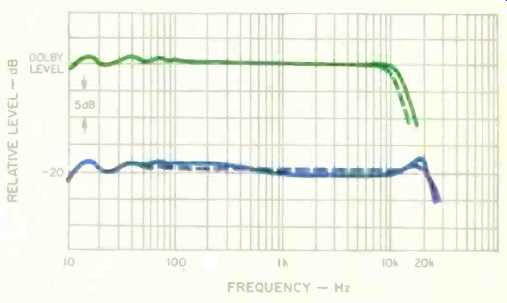
Fig. 1-Frequency responses with Scotch Master I tape with and without
(---) Dolby C NR.
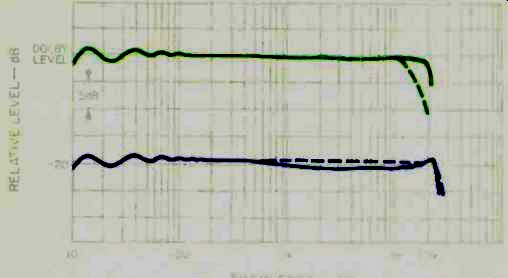
Fig. 2-Frequency responses with TDK SA-X tape with and without (---) Dolby
C NR.
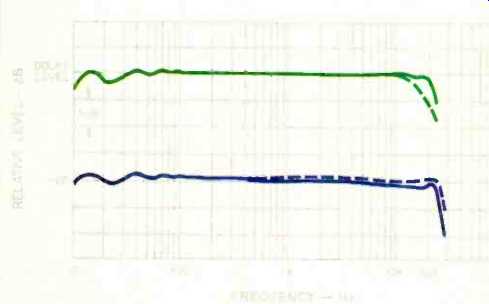
Fig. 3-Frequency responses with Sony Metallic tape with and without (---)
Dolby C NR.
After peaking azimuth with it, all points were within 2 dB for both equalizations. Tape play speed was about 0.2% fast, and indications for a standard level were slightly high. A large number of tapes were tried using the deck's CCC system, and excellent results were possible in every case, with the exception of a couple of low-bias ferrics. Because calibration included automatic setting of the meter sensitivity, an extra test step was necessary. Upon completion of Rec Cal, use of Stop and Tape Type with the keypad (1 to 5) allows reading out the actual bias, equalization, sensitivity and meter reference level ("07" = 250 nWb/m) in the four-digit display. For tests at Dolby level the reference is "05," so a readout of "11" would call for the test signal to be 6 dB below meter zero for Dolby-level recording Thus, there is some extra work for the evaluator, but not so for the user who will have the same meter readings whatever the tape. Of the many tapes that gave excellent results, Scotch Master I, TDK SA-X and Sony Metallic were selected for the detailed testing. Figures 1 to 3 show the swept-frequency plots at Dolby level and 20 dB below that, both with and without Dolby C NR. They are all quite flat over the entire band with relatively small Dolby NR mistracking. Take note of the increased headroom with Dolby C with contribution from B & 0/Dolby HX Professional, which is also quite evident in the Table I listing of the-3 dB points. The outstanding flatness of the responses is most obvious at Dolby level and without NR at-20 dB. Although the deck has three heads, there is no playback at the line outputs during the process of recording, and the headphone monitoring is of the input. This would be a limitation for those who need simultaneous playback.
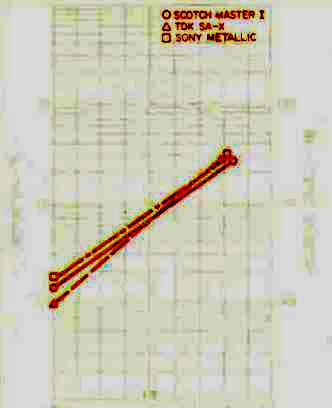
Fig. 4--Third-harmonic distortion vs. level at 1 kHz with Dolby C NR.

Table I--Record/playback responses (-3 dB limits).

Table II--Signal/noise ratios with IEC A and CCIR/ARM weightings.
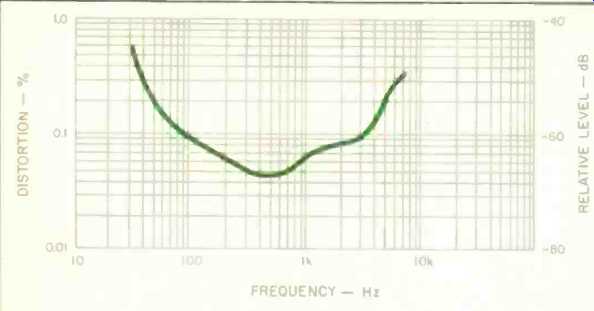
Fig. 5--Third-harmonic distortion vs. frequency with Dolby C NR at 10
dB below Dolby level with Sony Metallic tape.
Playback of a recorded 10-kHz tone had less than 25° phase discrepancy between tracks, and the jitter was just 15° total. The multiplex filter response was 37.0 dB down, right at 19 kHz. Separation and crosstalk at 1 kHz were 42 and 66 dB down respectively, both good figures. Erasure with metal tape at 100 Hz was a very good 67 dB. Figure 4 is a plotting of the results of measuring HDL3 (third-harmonic distortion) from-8 dB to the 3% limit in Dolby C mode with the three tapes. The curves are similar in most respects, with the 3% points in close correspondence. With the automatic meter calibrations, the meter zeros were at about +4 dB relative to Dolby level, and all were very close to the 2% B & O criterion. Figure 5 shows the variation in HDL3 over the frequency range of 30 Hz to 7 kHz at-10 dB with Dolby C NR using Sony Metallic tape.
The mid-band distortion was very low, with the expected rises at the frequency extremes, albeit lower than many decks. Signal-to-noise ratios were measured with the three tapes at Dolby level and at the 3% points with and without Dolby C NR with both IEC A and CCIR/ARM weightings. All of the results are superb, and they are the best to date measured on a cassette deck.
The input sensitivities were 0.15 mV for mike and 27 mV for line with TDK SA-X. Because of the automatic meter calibration, the tape type has an effect on the measured sensitivity for zero meter indication. A tape with lower MRL might nave garnered a line sensitivity of 15 mV, for example. This might be an oddity for the tester, but it is absolutely no problem for the user. The input overloads were 45 mV for mike and 4.0 V for line, both quite satisfactory. Output clipping appeared at a revel equivalent to about + 12 dB relative to meter zero. The line input impedance was a constant 11 kilohms across the band, and the input-pot settings had no effect on this value. The line output levels were adjustable (bottom-chassis trimmers) from about 400 mV to 2.4 V. When set to 1000 mV unloaded, they dropped to 700 mV with a 10-kilohm load, indicative of an output impedance of 4.2 kilohms. The headphone output was a hefty 1.4 V at 8 ohms, and very high levels were possible with any of the headphones tried, easily moderated with the slider. Because the feed to the meters is post-EQ, it is not possible to state the ±3 dB response limits. This is yet another challenge for the tester perhaps, but in this reviewer's opinion, it's a better way for setting record levels correctly to prevent unwanted distortion. The meters had a very fast response, reaching-1 dB with a burst of less than 3 mS, and the decay time was 0.9 S, also shorter than the IEC standard. Scale calibrations were very accurate, within 0.2 dB from "to "+5." Tape play speed was stable, and there were no changes with changes in line voltage. Flutter was ±0.08% weighted peak and 0.05% W rms with a slight rise at the very end of the tape pack with some cassettes. Wind times were 69 seconds for a C-60, and logic response times and run-out to stop were all one second or less.
Use and Listening Tests
Tape loading was simple and direct, and access for maintenance was excellent, as mentioned earlier. All switches and controls were completely reliable throughout the testing. The instruction manual has text that really is too concise, taking on a cryptic character in some instructions.
Some of the illustrations are too close-up, making general orientation difficult. A period of familiarization, therefore, is important with this deck to take best advantage of its features. Rec Cal readout of settings, for example, calls for the simultaneous use of Stop and Tape Type. If Tape Type is pushed first, by even the slightest time, tape type is changed, and there is no readout. Pushing Stop first, and then Tape Type immediately after, works every time. Rec Cal itself worked very well each and every time, always taking less than 10 seconds. Time and tape-end calibrations were useful on a number of occasions. Timer functions worked as expected, and it was rather handy to be able to read out real time whenever of interest. There were no record, pause or stop sounds detected by ear or by meter.
Listening tests of record/playback performance included pink noise (Dolby-tracking checks) and discs from Mobile Fidelity and dbx, with their encoding. It was possible to hear a shift in the pink-noise playback when Dolby C NR was used, but it was quite a subtle tilt with more bass, or was it less brightness? The disc copying did not result in a similar conclusion: There was excellent sound across the band, good solid bass and a clean high end. It was very easy to set levels for peaks to zero or slightly more, although the room lighting had to be kept low for best metering with the low-intensity display. It would have been helpful to have had lower level display segments for classical recording. At one point in the recording, there was a shift of energy to the lower bass, and there was an immediate indication of the need to reduce levels. In the playback, the short trip into distortion was apparent, but it was concluded that the post-EQ metering of the 9000 promptly showed the need for correction: The meters on most recorders would not have shown a change in level, and the distortion would have continued unabated.
The B & O deck does not offer some popular features, such as mike/line mixing or a multi-selection program scheme, and it requires a little time to "make friends." However, it will deliver excellent responses, superb signal-to-noise ratios, CCC and several time-related functions-all with a great metering scheme for its premium price.
-Howard A. Roberson
(Adapted from: Audio magazine, July 1982)
Also see:
Bang & Olufsen Beogram CD X Compact Disc Player (Mar. 1986)
Dual Model C-939 Auto-Reverse Cassette Deck (Equipment Profile, Apr. 1978)
= = = =